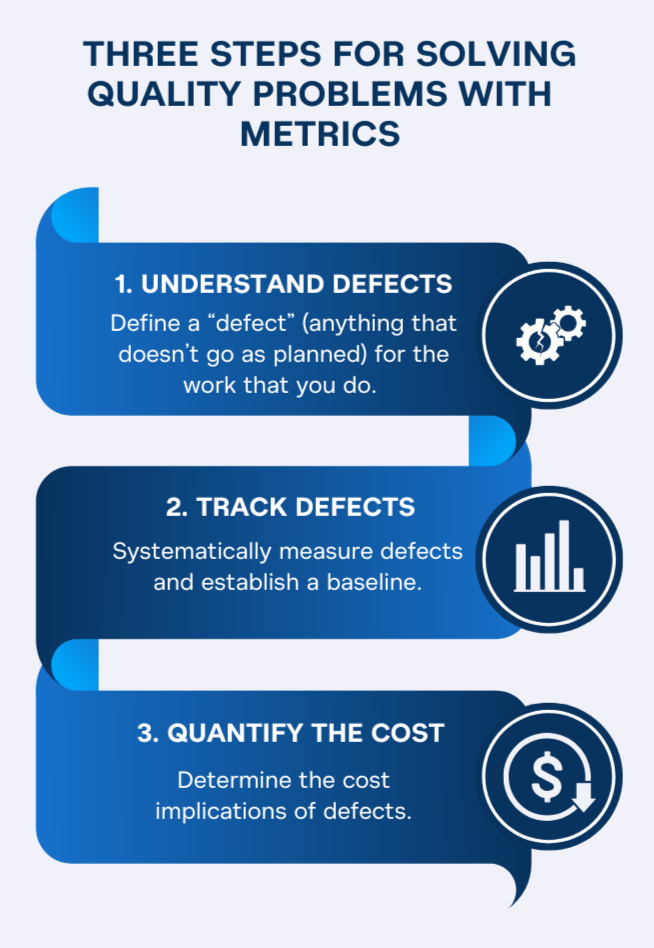When striving to improve quality in any organization, one critical yet often overlooked element is metrics. Metrics provide operational data, performance insights, and actionable information through dashboards. By leveraging metrics effectively, organizations can align their operations and achieve lasting success. In this blog, we’ll explore how to solve all your quality problems using three straightforward steps:
- Understand what a defect is for the work you do
- Track how many defects occur during a given period
- Quantify the cost of those defects

Let’s dive into each of these steps and see how they work in practice.
Step 1: Understand What a Defect Is
The first step in solving quality problems is clearly defining a defect for your work. A simple definition of a defect is anything that didn’t go as planned. Examples might include:
- A product manufactured incorrectly
- A patient in a hospital receiving the wrong dose of medication
- An incorrect invoice sent to a customer
Defects can vary widely depending on the industry, but the key is to create a clear and specific definition that everyone in the organization understands. Without this clarity, it’s impossible to measure or address quality issues effectively.
Step 2: Track How Many Defects Occur
Once you’ve defined a defect, the next step is to track how often it happens. Many organizations fail at this step because they don’t systematically measure defects, which makes it hard to identify recurring problems or determine the severity of the issue.
Tracking defects allows you to move beyond anecdotal evidence and establish a baseline. Knowing how often defects occur helps you determine if there is a trend or pattern that needs to be addressed, which is critical for prioritizing improvement efforts.
Step 3: Quantify the Cost of Defects
This final step is both the most challenging and the most important. Understanding the cost implications of defects transforms them from abstract issues into concrete problems that demand attention. Every defect has an associated cost, whether it’s the direct expense of rework or the indirect cost of lost customer satisfaction.
By clearly articulating these costs, you can:
- Gain leadership buy-in
- Drive urgency to address root causes
- Align team efforts toward improvement
Real-Life Example 1: Solving Defects in a Distribution Center
Let’s illustrate these principles with a real-world example. Years ago, I managed a distribution center (DC) for a large fast-food chain. We were one out of 27 DC’s supplying products to over 13,000 restaurants across the U.S. At the time, we tracked 25 metrics but focused on two key ones:
- On-Time Delivery: Did we deliver products to stores on time?
- Delivery Reliability: Did stores receive exactly what they ordered?
When I took over running the DC, we had a 96% on-time delivery rate (top 25% among all DCs) but an 83% delivery reliability rate. That meant that on average, 17 out of 100 stores didn’t receive the products they ordered daily. It was even more pronounced in that there were approximately 200 delivery issues per day for those 17 stores.
The Challenge
Despite these numbers, the leadership team was indifferent. The common refrain was, “That’s where we’ve always been,” or “We’re in the middle of the pack, so it’s not a big deal.” As a result, no one was motivated to make meaningful changes.
While we were already strong at understanding what a defect was and tracking how often it happened, this wasn’t enough to drive improvement. Something had to change.
The Solution
After observing daily operations meetings for a month, I realized the team’s focus needed to shift to costs. We revamped our approach and began discussing not just the number of defects but their financial impact. Each day, we calculated the costs of defects, using either actual expenses or standard estimates for hard-to-measure issues.
The results were eye-opening. We discovered that the 200 daily defects were costing anywhere from several thousand to over $10,000 each day —amounting to millions annually. This realization fundamentally changed the team’s perspective. Defects were no longer an abstract annoyance; they were a major financial drain that directly affected bonuses and our ability to provide low-cost products to restaurants.
By quantifying the cost of defects, we:
- Garnered leadership support
- Fostered a sense of urgency
- Unified the team around solving root causes
Real-Life Example 2: Addressing Quality Issues in Healthcare
Now, let’s look at a similar story from the medical industry. A mid-sized hospital faced recurring issues with medication errors. These errors ranged from incorrect dosages being administered to patients to delays in delivering medications to the right wards. While the hospital leadership acknowledged the problem, they struggled to drive meaningful improvements.
The Challenge
The hospital tracked medication errors but only in terms of incident counts. On average, there were about 15 errors per week, which seemed relatively low given the volume of patients. Leadership often dismissed the problem as “an unfortunate but acceptable risk in healthcare.” However, frontline staff knew these errors were causing harm to patients and increasing workloads through corrective actions.
The Solution
The turning point came when the quality improvement team decided to evaluate the financial impact of these errors. They discovered that:
- Each error cost the hospital an average of $1,000 due to corrective measures, extended patient stays, and potential liability.
- Over a year, these errors were costing the hospital nearly $780,000.
Armed with this data, the team implemented a new process to address the root causes of medication errors. They:
- Introduced barcoded medication administration (BCMA) technology to reduce human error.
- Provided targeted training for staff on common issues leading to mistakes.
- Enhanced their tracking system to monitor the financial impact in real-time.
The Results
Within six months, medication errors dropped by 60%, saving the hospital approximately $500,000 annually. More importantly, patient outcomes improved, and staff morale increased as workloads became more manageable. By quantifying the cost of defects, the hospital successfully turned a long-standing issue into a priority for improvement.
Unlock Your Organization’s Potential
Solving quality problems isn’t magic; it’s about focusing on the right metrics. By:
- Defining what a defect is
- Tracking how often defects occur
- Quantifying the cost of defects
You can unlock the potential for significant improvements in any organization. Metrics are the foundation of this process, providing the data and insights needed to drive change.
Quality isn’t just about meeting expectations—it’s about exceeding them and doing so efficiently. Start with these three steps, and you’ll be well on your way to solving your quality problems once and for all.





